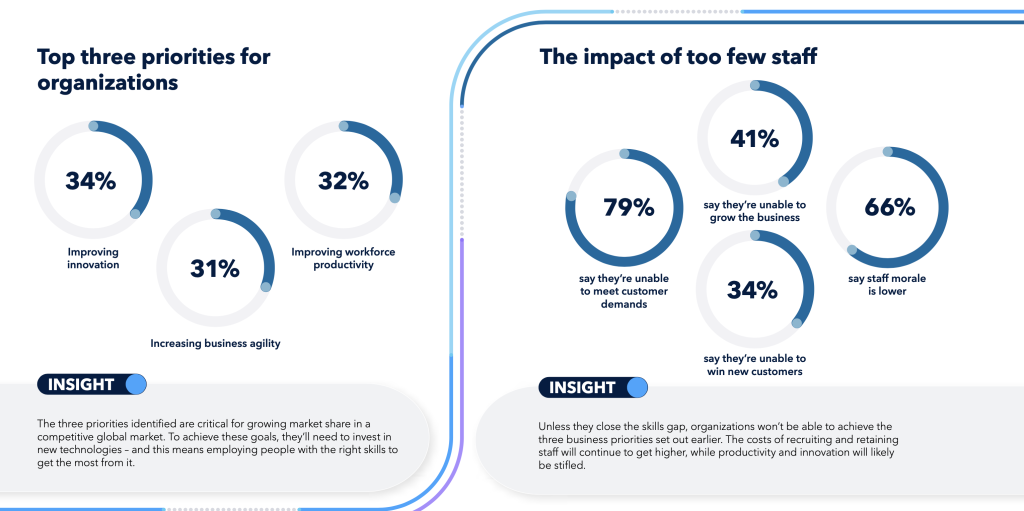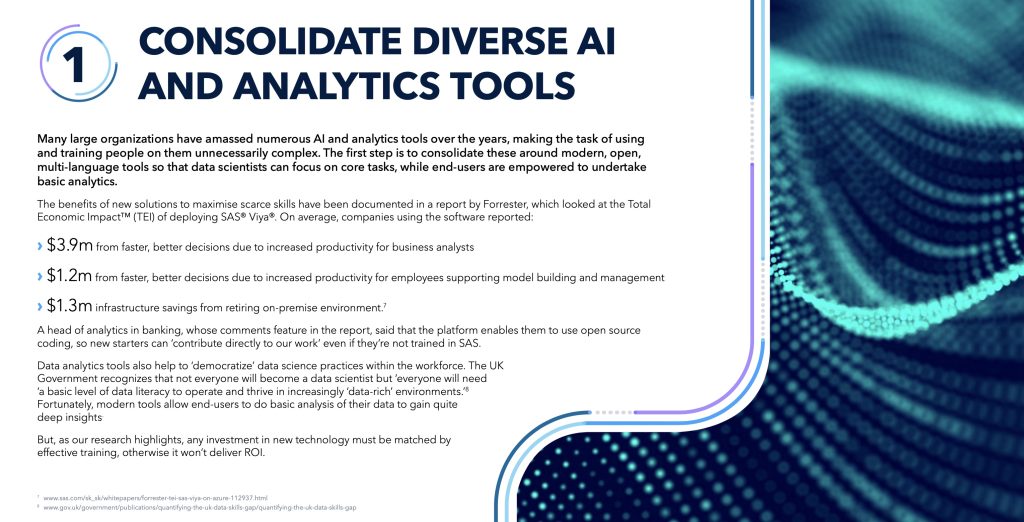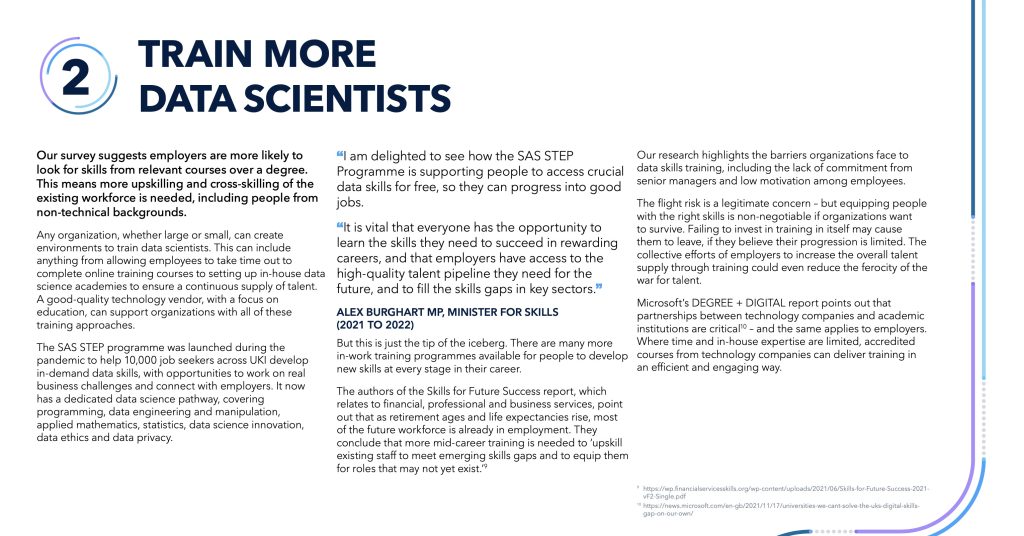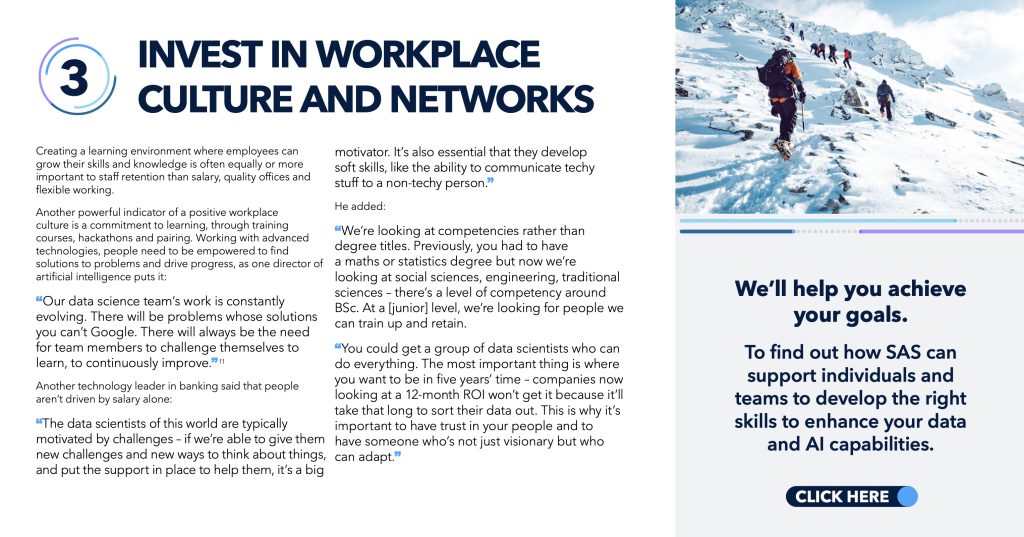From sparking innovation to reducing operational inefficiencies, top organizational priorities in the modern era depend on one thing: data. Because of its ability to uncover blind spots and power decision-making, data helps organizations identify growth areas and progress toward their strategic goals.
The catch?
Turning raw numbers into useful, valuable insights requires the help of professionals highly skilled in artificial intelligence (AI), machine learning (ML) and data analytics – and it's no secret that this talent is in short supply.
To better understand what organizations are experiencing firsthand, SAS and Coleman Parkes Research surveyed key decision-makers in 111 major organizations across the US and UK/Ireland with an average of 27,000 employees and developed this recent report, How to Solve the Data Science Skills Shortage, which sizes up the skills shortage, examines the broader impact and proposes a path forward.
The impact of a growing skills gap
According to Microsoft's DEGREE + DIGITAL report based on LinkedIn data, there's no skill set with a more significant disparity between supply and demand. And, based on projections from the U.S. Bureau of Labor Statistics, the demand isn’t expected to let up anytime soon. The bureau’s Office of Occupational Statistics and Employment Projections reports that the data science field is expected to grow by 36% from 2021-2031 – significantly faster than the average profession.
Many organizations are putting pressure on universities to ramp up their efforts to train graduates in high-demand data and analytics skills. Unfortunately, the outlook is grim.

According to estimates from the UK government, universities supply up to 10,000 data scientists annually. Meanwhile, LinkedIn boasts 38,000 job postings for data scientists in the UK– while the US suggests around 320,000 job postings. These figures, plus the rapid pace of technological change, show that institutions of higher education can’t fill the gap alone.
So, how can organizations close the skills gap and make real, sustainable progress toward their organizational goals? Rather than solely relying on academia or poaching talent, what can be done to secure necessary analytics skills?
1. Streamlining tools will keep organizations competitive
Surveying key decision-makers, the report found three top organizational priorities: improving innovation (34%), improving workforce productivity (32%) and increasing organizational agility (31%). Organizations lacking AI, ML and data analytics aren’t simply missing out; they’re also at risk of falling behind – threatening their overall resilience and competitiveness.
Because organizations focused on innovation are hungry to adopt emerging technologies, many have accumulated diverse tools over the years – creating a tangled web of resources. Consolidating AI and analytics tools to maximize their impact will ease the burden of bringing current and future employees up to speed.

By consolidating tools around modern, open, multi-language tools, organizations can improve the learning curve for end-users undertaking basic analytics, reduce inefficiencies and get the most value out of their data scientists by helping them focus on core tasks.
For many organizations, solutions like SAS® Viya®, which enable employees to use open-source coding, may be a good step forward. Examining the software’s Total Economic Impactä (TEI), a report by Forrester found that, on average, organizations deploying the platform reported over $5 million in increased productivity for business analysts from faster analytics processes and employees supporting model building and management, while seeing over $1 million in infrastructure savings from retiring on-premise environment.
2. Upskilling talent is necessary to drive innovation, growth
Finding that the organizations surveyed, like most, don’t have enough employees with skills to use the AI and ML technologies deployed causes broader implications. Too few analytics professionals prohibit organizations from meeting customer demands (79%), growing the organization (41%) or winning new customers (34%) – and 66% agree that their staff morale is lower. Coupled with an already-slim workforce capacity, this reality makes the war for talent even more complicated, driving up hiring and retaining costs. One solution that is not only cost-effective but increases morale is upskilling and cross-skilling the current workforce – even those from non-technical backgrounds.
For many organizations, investing in training resources comes with a certain degree of fear. What if their employees jump ship and go elsewhere after developing these in-demand skills? About 25% of survey respondents cited this fear and reluctance amongst senior management. Despite these barriers, training data scientists internally is necessary to plug the skills gap.

With such high demand for data talent, costs of new hires are surging – but more than half of the decision-makers surveyed agreed they wouldn’t need to recruit as many new hires if the current workforce could use data-based tools and technologies more effectively. Organizations can upskill and cross-skill employees, from slating time to complete accredited courses and certifications to hosting in-house boot camps and data science academies.
While on-the-job training can be tricky – organizations serious about driving their strategic priorities forward are faced with no choice.
3. Cultivating a positive work environment motivates employees
Finally, organizations can prepare for future success by fostering a positive workplace culture. While flexible working options, high salaries and high-quality office spaces and facilities are essential, developing environments where employees feel appreciated motivates employees and encourages them to stay.
Organizations should also focus on fostering and rewarding critical competencies and soft skills like curiosity, adaptability, collaboration and continuous learning. At this stage in the game, developing more quantifiable hard skills is non-negotiable – but because technology is constantly evolving, organizations should strive to develop employees eager to embrace new challenges and collaborate with others to tackle complex problems.
Offering training resources may have the opposite effect than managers fear it will. Rather than incentivizing staff to search for different jobs, investing in employees plays a vital role in motivating employees, improving morale, increasing productivity, and reducing turnover. And by helping staff advance their careers and demonstrating their value, creating a learning culture can also help secure employee loyalty.
In championing these environments, organizations prepare their employees for an uncertain future – and create spaces where top talent also want to work.
The need for data science skills isn’t going away and if not proactive about addressing the skills crisis, there will be a larger, rippling effect. Organizations – especially ones hungry to innovate, grow and invest in new data-based technologies – will need to take a robust, multifaceted approach to solve the problem.



